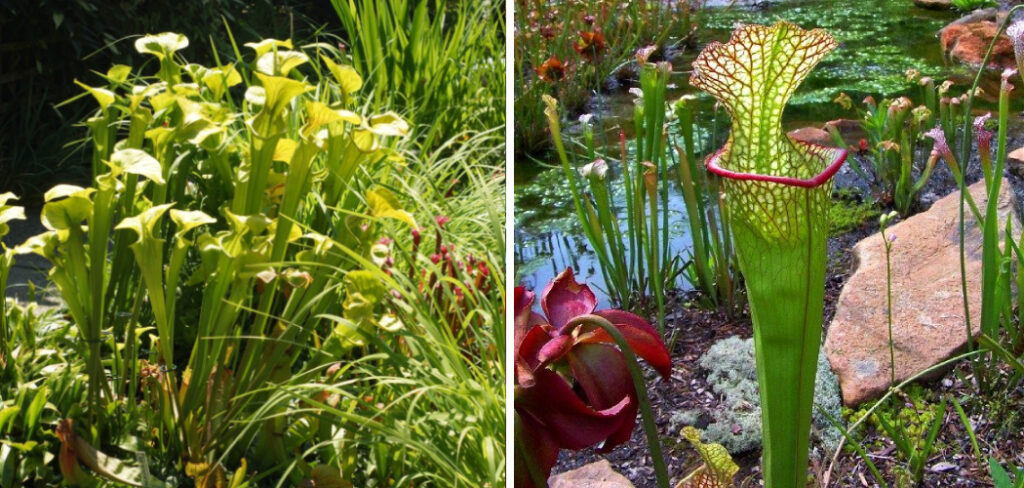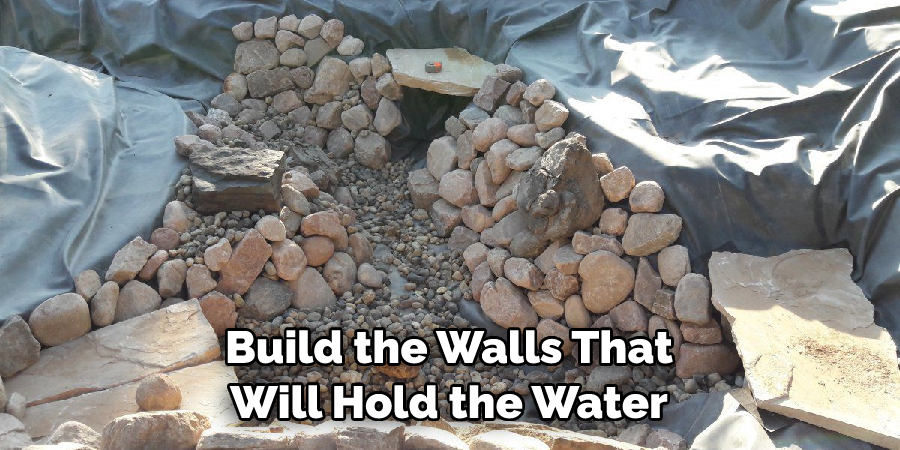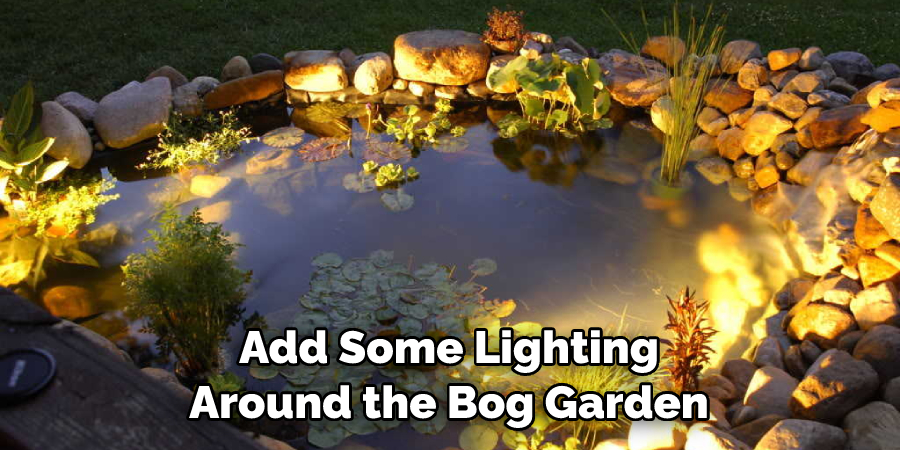Are you looking for a unique and interesting way to bring more life into your garden? If so, consider creating a bog garden! A bog garden is an easy and beautiful way of adding different plants to your outdoor space while also helping create habitats for animals.

With its moisture-retaining characteristics, bog gardens make it possible to grow exotic plants that typically don’t thrive in dry soil or warmer climates.
In this post on how to make a bog garden, we’ll discuss the basics of making your own Bog Garden, before exploring some great plant options that are perfect for this type of environment.
What is Bog Garden?
A bog garden is a type of garden created in an area where water collects, either naturally or by design. It is used to grow plants that thrive in wet soils and provides an ideal habitat for animals like frogs and dragonflies. They’re also great spots to attract birds, as they provide plenty of lush vegetation and standing water.
To create your own blog garden, you’ll need to construct a water-retaining area in your garden. This can be done with the help of retaining walls and a shallow moat or pond. Depending on the type of plants you want to grow, you may also need to add soil enhancements like peat moss or sand.
11 Step-by-step Guidelines on How to Make a Bog Garden
Step 1: Choose an ideal location
Make sure that the area is in a shady spot with plenty of sun exposure to keep the plants healthy and growing. Otherwise, you can also build a bog garden in a sunny spot but be sure to provide plenty of shade for the plants. It is also important to make sure that the spot you choose has a good water supply.
If not, you can install a pump to provide water or you can simply fill up the bog garden with a hose or watering can.
Step 2: Constructing the walls
The next step is to build the walls that will hold the water. These can be made from bricks, stones, or any other material. It’s important to make sure that the walls are at least six inches thick and two feet tall in order to retain enough water for the plants.
It is also important to construct the walls in a way that can easily be filled with water and drained when necessary.
It’s also a good idea to dig down several feet below the walls in order to allow for good drainage.

Step 3: Install a liner
Once you have created the walls, it’s time to install a liner to contain the water. This is important because it will help keep your bog garden free of contaminants and pests like mosquitoes. You can use landscape fabric, plastic sheeting, or even pond liners for this purpose.
This is also a good time to add an overflow pipe to allow excess water to drain away and prevent flooding. It’s also important to make sure that the liner is properly secured and sealed so that it doesn’t come loose or leak.
Step 4: Digging out the area
Now that you have constructed your retaining walls and installed a liner, it’s time to start digging out the area. This can be done by hand or with a shovel and should be at least eight inches deep so that it will hold enough water for the plants. If you are using a shovel, it is important to make sure that the sides of the area are level and even.
This will help keep water from collecting in one spot and give your bog garden a more natural look.
Step 5: Fill in the bog garden
Once you have dug out the area, fill it up with soil, peat moss, sand, or any other kind of material that will provide good drainage and help retain moisture. You may also want to add a mix of different types of soil as this will help create an even better environment for your plants.

It’s also important to make sure that the soil is not too dry or too wet as this can lead to root rot and other problems.
Step 6: Planting your Bog Garden
When selecting plants for your bog garden, make sure that they are suited to wet soils and shady conditions. Some great options include ferns, water lilies, and other bog plants. Make sure to place the plants in the soil so that they are at least an inch above the surface of the soil. This will help prevent the roots from getting too wet and also allow for good drainage.
Step 7: Fertilizing your bog garden
Similar to any other type of garden, you will need to fertilize your bog garden every few weeks with a liquid fertilizer or compost tea. This will help keep your plants healthy and growing strong. It’s also a good idea to add slow-release fertilizer to the soil every year or two as this will help keep your plants well-fed over time. But be sure to use a fertilizer that is specifically designed for bog gardens.
Step 8: Introducing wildlife
Bog gardens not only provide habitats for birds, but they also make great homes for frogs, dragonflies, and other types of animals. You can introduce these species by introducing their natural prey or by simply creating an inviting environment where they can find shelter and food.
It’s also a good idea to add rocks, logs, and other structures for them to hide in. In addition, be sure to fill your bog garden with native plants as these will provide food and shelter for the animals that inhabit it.
Step 9: Adding accessories
To complete your bog garden, consider adding a few decorative features like stepping stones, waterfalls, or birdbaths. These will help create an inviting environment for both you and the wildlife that visits your bog garden. This type of garden is also great for adding some color and texture to your landscape, so don’t be shy about experimenting with different accessories.
It’s also a good idea to add some lighting around the bog garden in order to enjoy it during the evenings.

Step 10: Maintaining your Bog Garden
Bog gardens require regular maintenance in order to keep them looking their best. This includes keeping the soil damp by adding more water when needed and pruning back any overgrown plants. You may also need to remove any debris or weeds from time to time. It’s also important to fertilize your bog garden regularly and watch for any signs of disease or pests.
Step 11: Enjoy!
Now it’s time to sit back and enjoy your beautiful bog garden! With its lush greenery and abundance of wildlife, your bog garden will be sure to become the envy of all your neighbors.
Always remember that this type of garden requires regular maintenance in order to keep it looking its best, but with a little bit of hard work and some patience, your bog garden will be sure to provide you with years of beauty and enjoyment.
Creating a bog garden is a fun and rewarding way to bring more life into your outdoor space. With its moisture-retaining characteristics, bog gardens make it possible to grow exotic plants that typically don’t thrive in dry soil or warmer climates.
Plus, they provide habitats for animals like frogs and dragonflies which can add even more beauty to your garden. Just follow these 11 simple steps on how to make a bog garden and you’ll soon have an oasis of lush greenery in no time!
Frequently Asked Questions
Q: Do I Need to Add Soil Enhancements?
A: Depending on the type of plants you want to grow, you may need to add soil enhancements like peat moss or sand. This will help to retain moisture and create the right environment for your plants to thrive in.
Q: What Types of Plant Should I Use?
A: When selecting plants for your bog garden, make sure that they are suited to wet soils and shady conditions. Some great options include ferns, water lilies, and other bog plants.
Q: How Often Should I Fertilize My Bog Garden?
A: You should fertilize your bog garden every few weeks with a liquid fertilizer or compost tea. This will help keep your plants healthy and growing strong.
Q: What Other Accessories Can I Add?
A: To complete your bog garden, consider adding a few decorative features like stepping stones, waterfalls, or birdbaths. These will help create an inviting environment for both you and the wildlife that visits your bog garden.

By following these guidelines on how to make a bog garden, you’ll soon be able to enjoy a lush green paradise in the comfort of your own backyard! Happy gardening!
Conclusion
Crafting a bog garden has been an engaging and rewarding experience. Not only have we discovered how to make a bog garden, but specialized knowledge has been imparted on what plants to use, how deep water should be, and the division between boggy areas and dry areas.
Now that you know the proper steps to creating your own amazing bog garden, it’s time to get started! Consider using the tips mentioned in this post and add them to your design for a unique touch. And if you’re looking to take your gardening game further and tackle a new project, try looking into how to make a rain gutter planter!
It’s just as fun and educational as making a bog garden, so don’t hesitate to jump right in and get creative. Keeping nature alive is important for our planet, and with all these insightful gardening alternatives, there is no better way to show your appreciation than own very own home oasis.
About
Outdoor Fixes is a distinguished figure in the world of Diy design, with a decade of expertise creating innovative and sustainable Diy solutions.
His professional focus lies in merging traditional craftsmanship with modern manufacturing techniques,
fostering designs that are both practical and environmentally conscious. As the author of diy,
outdoorfixes delves into the art and science of outdoorfixes-making, inspiring artisans and industry professionals alike.
Education RMIT University
(Melbourne, Australia) Associate Degree in Design (Outdoor Fixes) Focus on sustainable design, industry-driven projects,
and practical craftsmanship. Gained hands-on experience with traditional and digital manufacturing tools, such as CAD and CNC software.
Nottingham Trent University
(United Kingdom) Bachelor’s in outdoorfixes.com and Product Design (Honors) Specialized in product design with a focus on blending creativity with production
techniques. Participated in industry projects, working with companies like John Lewis and Vitsoe to gain real-world insights.
Publications and Impact
In diy, Outdoor Fixes his insights on indoor design processes, materials, and strategies for efficient production.
His writing bridges the gap between artisan knowledge and modern industry needs, making it a must-read for both budding designers and seasoned professionals.

